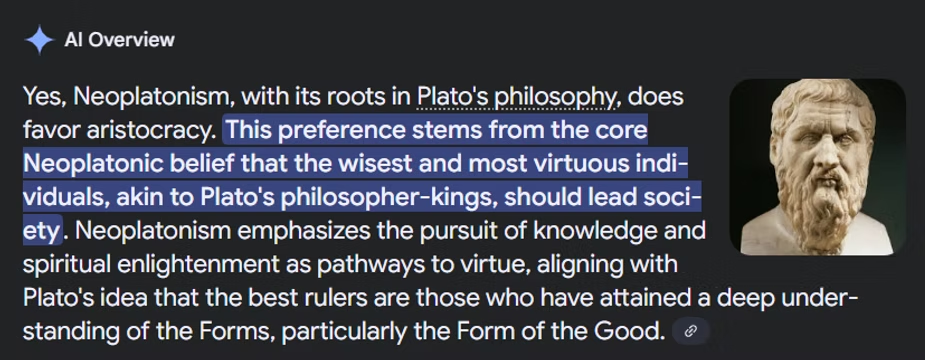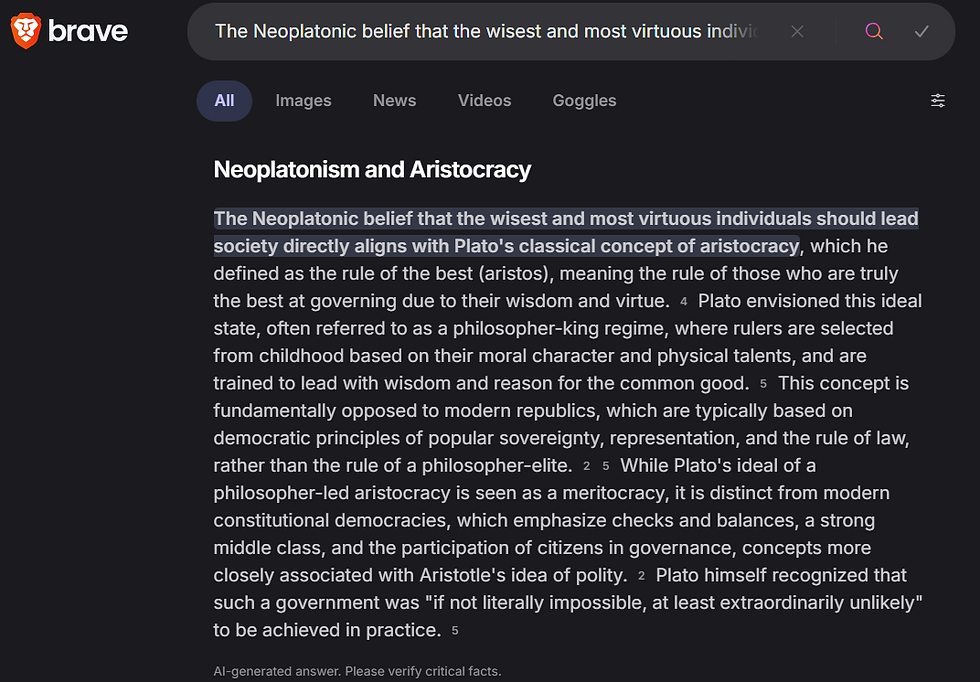Atlas
- Lafyva

- May 17, 2019
- 21 min read
Updated: Aug 15
"The generic name is derived from the Greek words ἄγκιστρον ankistron "fish-hook, hook"[7] and ὀδών odon "tooth",[8] and the specific name comes from the Latin piscis "fish"[9] and voro "(I) eat greedily, devour";[10] thus, the scientific name translates to "hook-toothed fish-eater".[11] Common names include variants on cottonmouth, water moccasin, swamp moccasin, black moccasin, and simply viper.[12] Many of the common names refer to the threat display, in which this species will often stand its ground and gape at an intruder, exposing the white lining of its mouth."
Leucolysin (EC 3.4.24.6, Leucostoma neutral proteinase, Leucostoma peptidase A) is an enzyme.[1][2] This enzyme catalyses the following chemical reaction
Cleavage of Phe1-Val, His5-Leu, Ala14-Leu, Gly20-Glu, Gly23-Phe and Phe24-Phe bonds in insulin B chain as well as N-blocked dipeptides
This enzyme is isolated from the venom of the western cottonmouth moccasin snake (Agkistrodon piscivorus leucostoma).
Cfa: C = Mild temperate f = Fully humid a = Hot Summer
Cwa: C = Mild temperate w = Dry Winter a = Hot Summer

2013 Activity and Specificity Solutions of crude Agkistrodon piscivorus leucostoma venom hydrolyze a multiplicity of ester and peptide substrates [1]. The homogeneous leucolysin, however, hydrolyzes only peptides, separating it from the venom esterases. The enzyme contains 1 mol zinc and 2 mol calcium per mol of protein and its activity is completely inhibited by EDTA. It is also inhibited with 5 mM 1,10-phenanthroline (a poor chelating agent for Ca2+) in the presence of 10 mM Ca2+ [2]. The metal chelator-inhibited enzyme can be restored to full activity by the addition of Zn2+. Presumably, the two calcium ions have structural requirements [2]. Thus, leucolysin was the first well-characterized snake venom metallopeptidase and is still among the few venom proteases properly characterized as a zinc metalloendopeptidase. Leucolysin was isolated as the major protease active toward hemoglobin in Agkistrodon piscivorus leucostoma venom [3]. The purified enzyme possesses none of the other peptidase or esterase activities detectable in crude venom, e.g. activity toward Bz-l-Arg-OEt or l-Leu-NHPhNO2, substrates commonly used to assay trypsin-like enzymes and aminopeptidases, respectively [3]. Its hemorrhagic and fibrogenolytic activities have not been characterized. Leucolysin will hydrolyze N-blocked dipeptides such as Z-Gly↓Arg-OH, Z-Gly↓PheNH2 but not Z-Gly-Leu. Using the B chain of oxidized insulin as a substrate, cleavage specificity is towards Leu and Phe residues in the P′ position (residues 6, 11, 15, 24 and 25):
The natural substrate(s) of leucolysin have not been identified; therefore, its contribution to the toxicity of venom is not known.
The comparatively high level of proteolytic activity in the
venom of Agkistrodon piscivorus leucostoma (cottonmouth
water moccasin) was the criterion for selecting it from a
group of venoms from North American snakes for vigorous
biochemical characterization (Wagner & Prescott, 1966). All
of the information on the major protease (leucolysin) in this
venom originated from John Prescott's laboratory at Texas A
& M University and was performed prior to the development
of recombinant molecular biology techniques or microprotein
sequencing techniques.
AI Overview
Learn more
Yes, "leucostoma" venom is specifically associated with the Western Cottonmouth snake (Agkistrodon piscivorus leucostoma), meaning it is only found in this subspecies of cottonmouth snake; the term "leucostoma" refers to the scientific classification of the Western Cottonmouth, making its venom unique to that specific snake.
Key points:
Specific to Western Cottonmouth: The "leucostoma" venom is only found in the Western Cottonmouth snake.
Scientific Classification: "Leucostoma" is the subspecies designation for the Western Cottonmouth.
Venom Characteristics: Research on cottonmouth venom often specifically mentions "leucolysin," a protease found in the venom of the Western Cottonmouth.


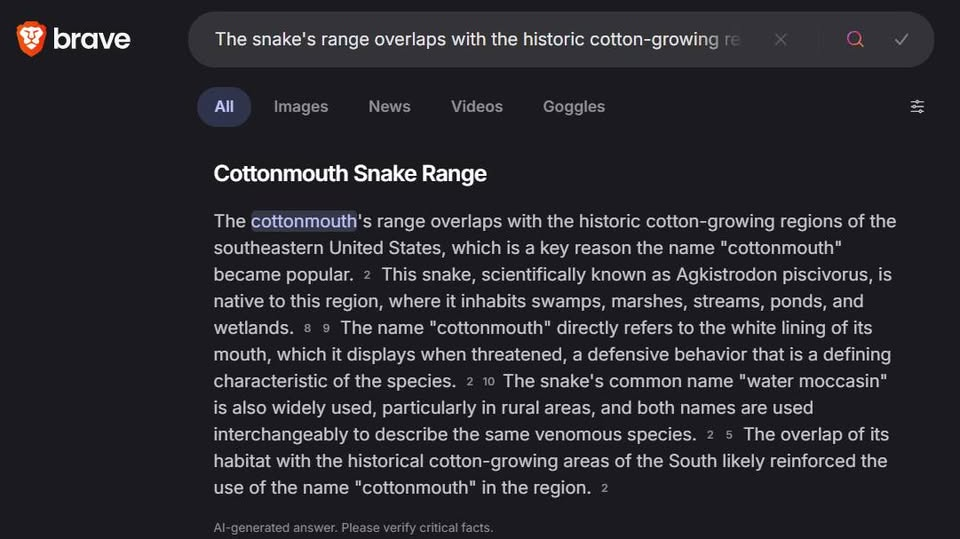



The Baptists separated from the Church of England because they believed church membership should be voluntary and that only believers should be baptized. They rejected the parish structure of the Church of England where people were "born" into the church and baptized as infants. John Smyth led the first congregation; Thomas Helwys traveled back to England the founded the first Baptist church there in 1612. The first Baptist church in North America was established by Roger Williams in what today is Providence, Rhode Island; soon thereafter, John Clarke founded a Baptist church in Newport, R.I.
AI Overview
Learn more…Opens in new tab
This statement is true; the vast majority of people involved in the abolitionist movement were deeply religious, often believing that slavery violated divine law and using their faith as a core motivation to fight against it.
Key points about the connection between religion and abolitionism:
Religious foundation:
Many abolitionists, particularly early leaders, were Quakers who strongly condemned slavery based on their religious beliefs.
Interpretation of scripture:
Abolitionists often interpreted the Bible as supporting the idea of human equality and condemning slavery.
Moral imperative:
They viewed ending slavery as a moral duty mandated by God.
Church activism:
Many abolitionists were active within their churches, preaching against slavery and advocating for its abolition.
Summary
The year 2007 marks the 200th anniversary of the abolition of the slave trade by
the British Parliament. The campaign for abolition was spearheaded by devout
Christians, and it stands to this day as perhaps the finest political achievement of
what would now be called faith-based activism. But who were the abolitionists,
and how did their Christianity motivate them to campaign against the slave
trade? This paper examines the Christian mind of the abolitionists, and ponders
the lessons for today.
The Republican Party, retroactively called the Democratic-Republican Party (a modern term created by modern historians and political scientists), and also referred to as the Jeffersonian Republican Party among other names,[a] was an American political party founded by Thomas Jefferson and James Madison in the early 1790s that championed liberalism, republicanism, individual liberty, equal rights, decentralization, free markets, free trade, agrarianism, and sympathy with the French Revolution. The party became increasingly dominant after the 1800 elections as the opposing Federalist Party collapsed.
In full: James Madison, Jr.
Born: March 16 [March 5, Old Style], 1751, Port Conway, Virginia [U.S.]
Died: June 28, 1836, Montpelier, Virginia, U.S. (aged 85)
Title / Office: presidency of the United States of America (1809-1817), United States House of Representatives (1789-1797), United States Continental Congress (1780-1783), United States
Political Affiliation: Democratic-Republican Party
Awards And Honors: Hall of Fame (1905)
The Federalist Papers is a collection of 85 articles and essays written by Alexander Hamilton, James Madison, and John Jay under the collective pseudonym "Publius" to promote the ratification of the Constitution of the United States. The collection was commonly known as The Federalist until the name The Federalist Papers emerged in the twentieth century.
James Madison (March 16, 1751[b] – June 28, 1836) was an American statesman, diplomat, and Founding Father who served as the 4th president of the United States from 1809 to 1817. He is hailed as the "Father of the Constitution" for his pivotal role in drafting and promoting the Constitution of the United States and the Bill of Rights. Disillusioned by the weak national government established by the Articles of Confederation, he helped organize the Constitutional Convention, which produced a new constitution. Madison's Virginia Plan served as the basis for the Constitutional Convention's deliberations, and he was one of the most influential individuals at the convention. He became one of the leaders in the movement to ratify the Constitution, and he joined with Alexander Hamilton and John Jay in writing The Federalist Papers, a series of pro-ratification essays that was one of the most influential works of political science in American history.
Stilling their opposition in order to support the first administration of U.S. Pres. George Washington, the Anti-Federalists in 1791 became the nucleus of the Jeffersonian Republican Party (subsequently Democratic-Republican, finally Democratic) as strict constructionists of the new Constitution and in opposition to a strong national fiscal policy.
From 1794 to 1797, Thomas Jefferson operated as the informal leader of what would become the nation's first opposition political party, the Democratic-Republicans.
The Democratic-Republican Party was founded in 1791-92 by Thomas Jefferson and James Madison.
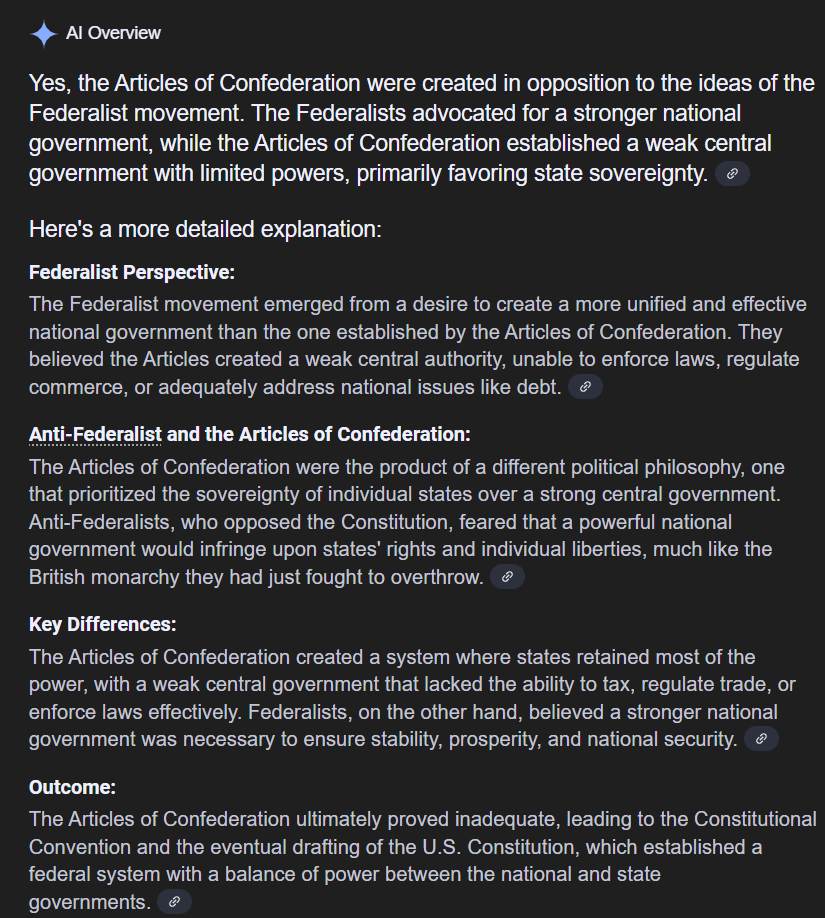
AI Overview
Learn more
Yes, the Articles of Confederation were designed against the principles of federalism, as they created a very weak central government with most power residing with the individual states, essentially forming a confederacy where states retained primary sovereignty rather than sharing power with a national government; this stands in direct contrast to the federalist system established by the later U.S. Constitution.
Key points about the Articles of Confederation and federalism:
Limited national power:Under the Articles, the national government had very limited powers, including no ability to directly tax citizens or regulate interstate commerce, making it heavily reliant on the states for funding and cooperation.
State sovereignty:The Articles emphasized the individual sovereignty of each state, allowing them to act largely independently from the national government.
No strong executive or judiciary:The Articles lacked a separate executive or judicial branch, further weakening the central government.
Unanimous consent required:Any significant changes to the Articles required unanimous agreement from all states, making amendments nearly impossible.
AI Overview
Learn more
Yes, Federalists strongly opposed the Articles of Confederation during the Revolutionary War, arguing that it created a weak central government that could not effectively lead the nation and needed to be replaced with a stronger constitution with more power vested in the federal government.
Key points about Federalists and the Articles of Confederation:
Weakness of the Articles:
Federalists believed the Articles gave too much power to individual states and not enough to the national government, making it difficult to raise taxes, regulate trade, and maintain stability.
Need for a strong central government:
They advocated for a new constitution that would establish a stronger federal government capable of addressing national issues like defense and economic policy.
"The Federalist Papers":
To support their arguments, prominent Federalists like Alexander Hamilton, James Madison, and John Jay wrote a series of essays called "The Federalist Papers" explaining the benefits of a stronger national government.
AI Overview
Yes, Federalists opposed the Bill of Rights because they believed it was unnecessary and potentially dangerous.
Explanation
Federalists believed that the Constitution already limited the government's power, so a bill of rights was unnecessary.
They thought that listing rights would imply that the government had the power to regulate those rights, even if the Constitution didn't explicitly state that power.
Federalists believed that a bill of rights would be ineffective in times of crisis, when it would be overridden.
They believed that the people would best protect their rights through a representative government.
Federalists believed that the people would decide whether to allow the government to violate their rights.
The Anti-Federalists, who opposed the Constitution, believed that a bill of rights was necessary to protect the people's liberties. The Anti-Federalists' opposition was a major factor in the adoption of the Bill of Rights.
Brave AI rather than Google AI
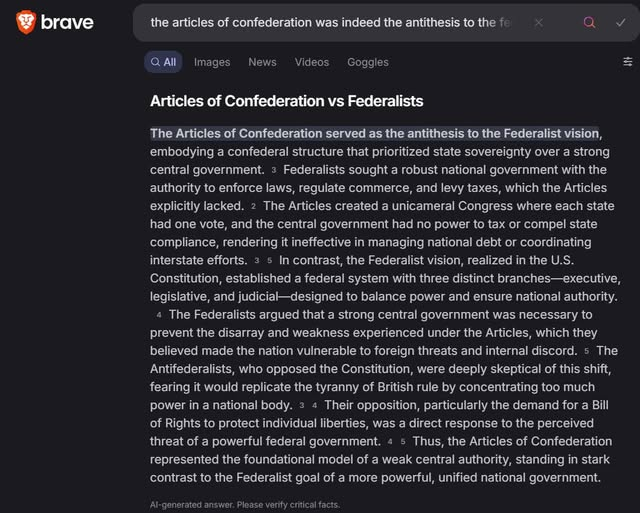
The Articles of Confederation were adopted by the Continental Congress on November 15, 1777. This document served as the United States' first constitution. It was in force from March 1, 1781, until 1789 when the present-day Constitution went into effect.
The Anti-Federalists opposed the ratification of the 1787 U.S. Constitution because they feared that the new national government would be too powerful and thus threaten individual liberties, given the absence of a bill of rights.
Their opposition was an important factor leading to the adoption of the First Amendment and the other nine amendments that constitute the Bill of Rights.
The Revenue Act of 1861, formally cited as Act of August 5, 1861, Chap. XLV, 12 Stat. 292, included the first U.S. Federal income tax statute (see Sec. 49).
Passed by Congress on July 2, 1909, and ratified February 3, 1913, the 16th amendment established Congress's right to impose a Federal income tax.
The most popular explanation of the causes of historical change and especially of the rise and fall of civilizations has been by means of some biological analogy in which a people, once young and vigorous, were softened and weakened by rising standards of living, or by a loss of the ideology of hard work and self-sacrifice that had made their rise possible. In most cases little or no effort has been made to correlate this process of change with the various stages through which the civilization was said to have passed. In some cases this "softening of fiber" theory has been presented in a more naive form by a simple biological analogy in which civiliza- tions, like man himself, were felt to pass through a simple sequence of youth, maturity, and old age. In many cases no real explanation of the process of change has been given at all, the theorists in question being satisfied with attaching names to the various stages of historical change. Giovanni Battista Vico, for example, saw the history of each people as a process by which barbarian vigor slowly developed into rationalism, the period of greatest success being merely the middle period when the two qualities of vigor and rationality were in a fruitful, precarious, and temporary balance, while the decline was due to the final triumph of rationalism over energy. In the late nineteenth century, as biological sciences became more influential, these basic ideas were reserved with varying quantities of biological sauces. The Russian thinker Nikolai Danilevsky attributed the earlier period of vigor to biologic mixture of peoples, and attributed the intermediate ages of greatest achievement to the rise of a state organization that could direct such energies into more productive channels. The final stage of decay is not clearly explained but seems to be attributed to some process of po- litical institutionalization not too remote from the explana- tion offered here. At the turn from the nineteenth to the twentieth century, the influences of Darwinian thinking became dominant in theories of civilization dynamics. W. M. Flinders Petrie in 1911 offered a Darwinian version of the theories of earlier writers such as Danilevsky: an earlier period of struggle, based on the vigorous energy of barbarian intruders, was gradually weakened by the enjoyment of rising standards of living which weakened "strife." Enunciating the general rule, "There is no advance without strife," Petrie pictured each cycle as an accelerating decay resulting from a decrease in "strife." This point of view, generally accepted by many of the earlier theorists on this subject, saw the later stages of any civilization as a period of decreasing strife or violence, a conclusion which seems to be sharply at variance with the facts. To Oswald Spengler, one of the most famous of modern writers on this subject, a similar pattern was evident. He discerned in each people an earlier stage of vigorous creativity that he called "culture" and a later stage of weakening moral fiber and devotion to selfish physical comforts that he called "civilization." As is usual among writers on this subject, no real explanation was provided for this loss of motion, although the pattern was applied to ten different "cultures." The most famous of recent writers on this subject, Arnold J. Toynbee, has produced the most voluminous and, in spite of its sprawling organization, most satisfactory theory of these processes. He is still strongly influenced by Darwinian biology, and attributes rise and fall of civilizations to the "challenge and response" to "the struggle for existence." In spite of his many improvements over earlier writers, especially in regard to the units to which this pattern applies and the stages through which the pattern takes each unit, Tony- bee's theories have several of the prevalent inadequacies of earlier writers, especially in his failure to correlate the stages of change with the process of change and, above all, in his failure to explain why a civilization which has been "responding" to "challenges" successfully for centuries gradually ceases to do so, and decays.
The Evolution of Civilizations
Being Christian students of Tanakh, the Pilgrims modeled the constitutions and laws of their “promised land” of the original thirteen colonies on biblical principles. Interestingly, although Tanakh clearly lists twelve tribes, confusion sometimes exists, for reasons not germane to the matter at hand, as to whether there were twelve or thirteen tribes.
Unfortunately, the Pilgrims’ limited understanding of Tanakh was not confined to comparatively simple matters such as whether there were twelve or thirteen tribes. On July 1, 1620, the Pilgrims, prior to departing Plymouth, England, signed a seven-year contract in which they agreed to pool “all profits and benefits that are got by trade, traffic, trucking, working, fishing, or any other means of any person or persons” The contract further provided “that at the end of the seven years, the capital and profits, viz. The houses, lands, goods and chattels, be equally divided” In other words, the Pilgrims brought socialism to America.
However, instead of lasting seven years, the Pilgrims’ experiment with socialism failed after a mere two years. Shortages and starvation abounded; about 50 percent of the colonists died of starvation and related illnesses.
Under the leadership of their governor, William Bradford, the Pilgrims scuttled their socialist experiment and adopted a free-market economy. The effects of a free-market economy were both immediate and dramatic. When the Pilgrims were allowed to retain the fruits of their labor, their productivity—and prosperity—increased almost overnight.
In the 1950s and 1960s, many development economists believed in the “vicious cycle of poverty” theory, which argued that poverty in the developing world prevented the accumulation of domestic savings.
In short, the theoretical case for foreign aid is, at best, questionable, and aid’s practical impact on some of the world’s poorest economies may well have been harmful.
https://www.quora.com/What-are-the-mechanisms-of-evolution
https://www.amazon.com/Intended-Evolution-Selection-Intelligence-Forward/dp/1632990180
http://www.answers.com/Q/Is_one_kidney_better_than_two#slide=2 https://weillcornell.org/services/kidney-and-pancreas-transplantation/living-donor-kidney-center/about-the-program/risks-and-benefits-of-living-donation
On November 1, 1952, the Teller–Ulam configuration was tested at full scale in the "Ivy Mike" shot at an island in the Enewetak Atoll, with a yield of 10.4 megatons (over 450 times more powerful than the bomb dropped on Nagasaki during World War II). https://en.wikipedia.org/wiki/Thermonuclear_weapon#United_States
https://www.petmd.com/blogs/thedailyvet/pmahaney/2011/nov/dispelling_the_mixed_breed_health_myth-12067
https://extension.umaine.edu/publications/2279e/ http://www.sciencedirect.com/science/article/pii/S0378112703005176
eye color:
1 in 41 males have ASD up 120% from 2002
Based on this diet, blood type O-positive individuals should consume organic lean meat and poultry, fruits, and vegetables. This high protein and low carbohydrate diet recommends limiting or avoiding wheat products, dairy, caffeine and alcohol.
This diet group is referred to as “The Hunter” and closely follows the lines of the Paleo diet, theorizing that ancestors of O-positive people only ate what they could hunt or gather at the time. Regular exercise of high-functioning workouts is linked to this diet.
A story of extinction:
"Throughout the region in former times, the public sector dominated the economy. In some countries (e.g., Egypt, Algeria and Syria) this dominance was a product of ideology (the so-called Arab Socialism), while in some conservative coun-tries (e.g., Saudi Arabia) it was related to pragmatic rather than ideological reasons (Richards and Waterbury 1991). Since the early 1980s, virtually all countries have moved away from complete or nearly complete public-sector dominance, and the private sector has played an increasingly important role."
" These observations leads to several conclusions regarding the effect of female labour force participation on fertility transition in Arab countries. First, female labour force participation may have negatively influenced fertility levels"
" Fourth, the proportion of educated women who are involved in work activities has declined. Table 5 shows that in Egypt, Morocco and northern Sudan the proportions of ever-married women with at least intermediate education who were involved in work activities declined between the1980s and 1990s. This trend reflects the increas-ing problem of unemployment experienced by the educated people, both male and female, of these countries. Most working females are employed in occupations that are provided by the public sector, in education, health, and social services. With the policy of public-sector retrenchment and fiscal austerity, new employment opportu-nities for females have become increasingly limited, and many working females have lost their jobs. For example, in Algeria the proportion of working women who were employed in public corporations declined from 34 per cent in 1990 to 24 per cent in 2000 (League of Arab States et al. 2004). " )
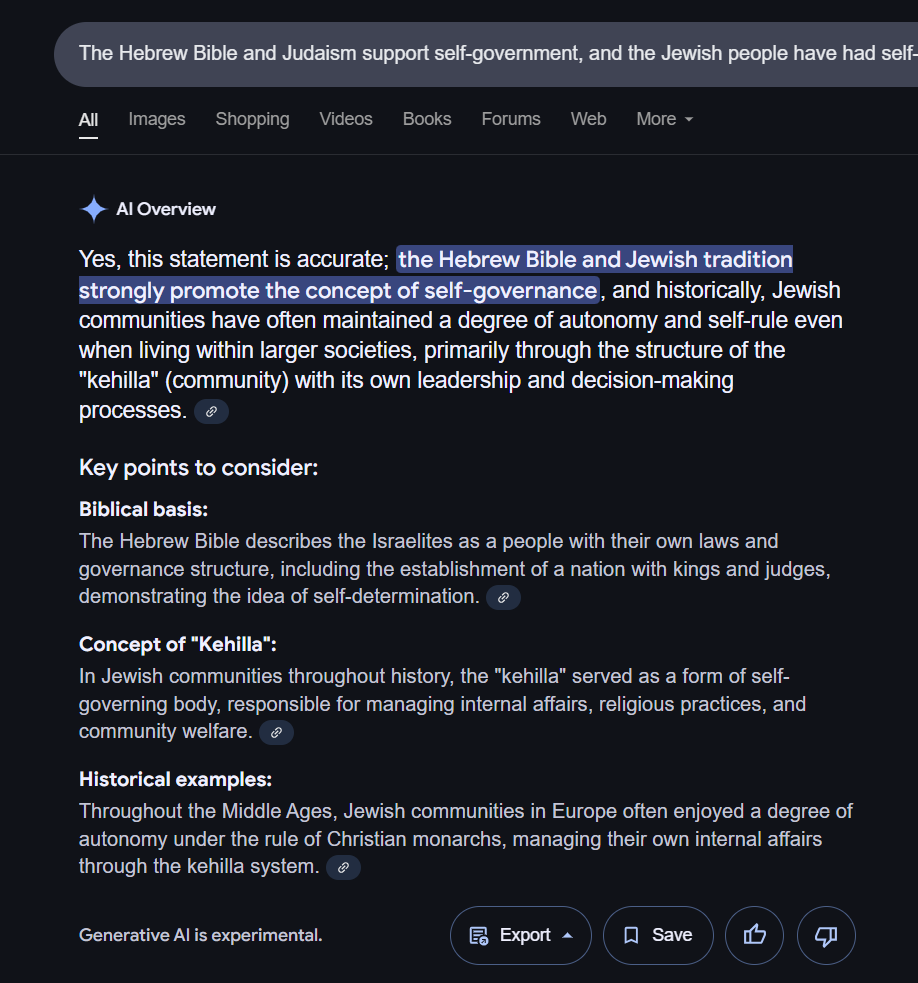

AI Overview
Learn more
Yes, when the Romans overthrew the Etruscan monarchy, they were indeed rebelling against a line of non-Jewish rulers from the Etruscan civilization; the Etruscans were an ancient Italian people with their own distinct culture and religion, completely separate from Judaism.
AI Overview
Learn more
Yes, the Romans revolted against the Etruscan kings primarily because they wanted to establish a republic, a system of government where power was not concentrated in the hands of a single monarch, but instead shared among elected officials and the people; this marked a significant shift away from the rule of kings.
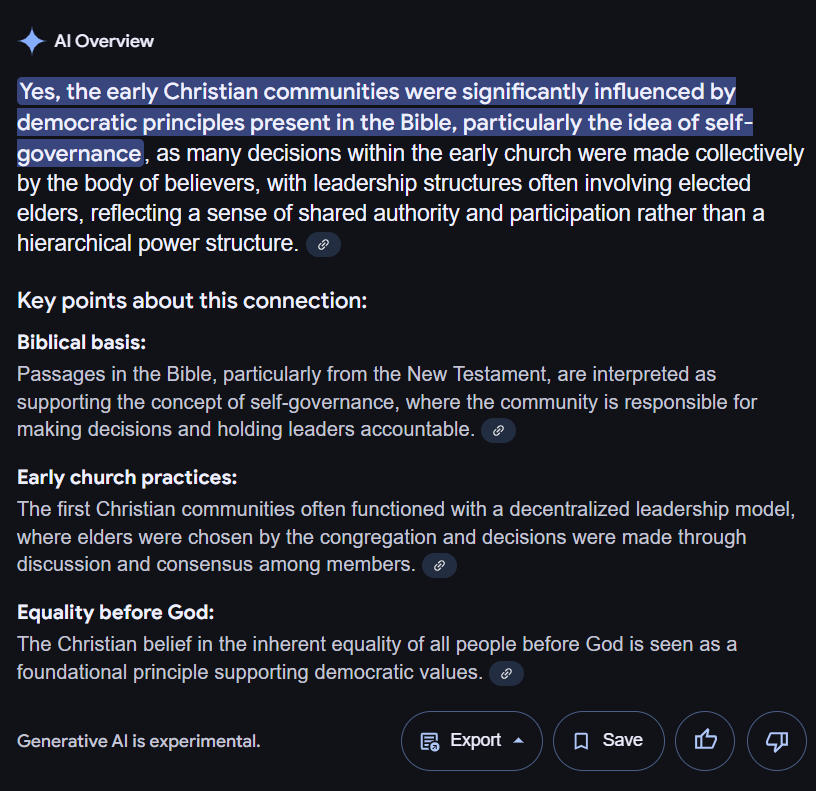
Jefferson's unorthodox religious beliefs became an important issue in the 1800 presidential election.[356] Federalists attacked him as an atheist.
After founding and naming Rome (as the story goes), he permitted men of all classes to come to Rome as citizens, including slaves and freemen without distinction.
Democracy is a soft variant of communism, and rarely in the history of ideas has it been taken for anything else.
George Washington: “Democracy is nothing more than mob rule, where fifty-one percent of the people may take away the rights of the other forty-nine.”
James Madison “The two great points of difference between a democracy and a republic are: first, the delegation of the government, in the latter, to a small number of citizens elected by the rest; secondly, the greater number of citizens, and greater sphere of country, over which the latter may be extended”
Motivated ignorance, rationality, and democratic politics
Essentialism
The first Christian communities were "inspirationally democratic", see the Athenian origion of core Christian terminology, ekklasia, leitourgia.
Like many other developing-country leaders, former Indian Prime Minister Rajiv Gandhi learned this lesson during the second half of the 1980s. His high-profile efforts to `modernise' and `liberalise' the Indian economy lasted less than three years before they were effectively abandoned doned in favour of the more comfortable path of state-led development. Powerful interests, both inside and outside the state, were credited with forcing Rajiv's retreat from liberalisation. Democracy's theoretical aversionsion to change seemed confirmed. That liberalisation eventually returned to India in a much more dramatic and lasting form under Prime Minister P. V. Narasimha Rao and Finance Minister Manmohan Singh is thus a puzzle worth untangling. The political durability of India's reform programme gramme runs counter not only to much of the experience in the rest of the developing world, but also to India's own lacklustre track record.
Rob Jenkins. Democratic Politics and Economic Reform in India (Contemporary South Asia) (Kindle Locations 92-95). Kindle Edition.
In short, there are two variants of conventional wisdom about the relationship between democracy and the promotion of policy reform, and both are wrong. Democracies are less constrained by unholy interest-group group coalitions than was previously thought, but neither are they paragons gons of consensus-building. Democratically elected governments operate in a complicated world in which obfuscation and betrayal are routinely used to achieve political ends. Arguably democracy makes such tactics both necessary and possible. Advanced capitalist democracies rely on them all the time. Nevertheless, the explanation advanced in this book is not simply that India's reformers were Machiavellian enough to outwit opponents of liberalisation. Our concern is with the system within which reform was sustained. We identify three aspects of that system, around which the case material is structured: political incentives, political institutions, tions, and political skills.
Rob Jenkins. Democratic Politics and Economic Reform in India (Contemporary South Asia) (Kindle Locations 123-127). Kindle Edition.
Similarity, Sameness, Groups, Cooperation:
Myth of under nutritioned ancestors, medical anti racism, misrepresentation, and lies about undernutritonal growth retardation :
Perhaps the major puzzle is why Africans are so tall.
Genetic adaptations in height, ect after agriculture:
Is the 20th century increase in human height entirely nongenetic?
There is strong evidence that the heritability of European height has increased over the past century (Silventoinen et al., 2000; Silventoinen et al., 2003).
We hypothesized that a shift toward gender equality in 19th century Sweden increased mate selection freedom for women and amplified sexual selection for height. A mathematical model supported environmental factors as the main force driving population height change, and suggested a limited role for sexual selection. More generally, the model provides a framework for studying interactions between cultural change and evolutionary selection mechanisms.
However, since the increasing trends in body height during the last century have generally been very similar in European populations, it is probable that genetic factors are most important when explaining these geographic differences in height. If environmental factors were the main explanation, it is likely that the differences in body height between European countries would have diminished after the Second World War simultaneously with the increasing standard of living in Europe, as occurred in body height differences between Sweden and Finland (Silventoinen et al., 2001b)
"Microcephaly is a lifelong condition."
There is increasing evidence from preclinical and human studies that nutrition in the late foetal and early neonatal period has a significant impact on neurodevelopment across the lifespan.
Conclusion: Optimizing nutrition during foetal and early postnatal life is a golden opportunity to impact neurodevelopment and brain function across the lifespan.
"Children suffering from stunting may never grow to their full height or develop their full cognitive potential"
Linear growth retardation (stunting) is associated with lower adult cognition, educational attainment, and income.
Background: Undernutrition among pre-school children is a major public health issue in the developing countries including India. Head circumference (HC) is a simple, non-invasive and inexpensive anthropometric measure reflecting physical cranial growth and is considered as an indicator of past nutrition status and development of the brain.
The present study recommends routine measurement of HC to assess
undernutrition among pre-school children.
"Although severe degrees of intrauterine growth retardation are associated with poorer cognitive performance in later life(Strauss, 2000; Hacket al., 2002), it is less clear whether variation in early growth within the normal range affects higher mental function."
"Findings in our study linking full-scale, performance and verbal IQ in 9-year-old children to measurements of head circumference made currently and at 9 months of age, but not those made at 18 weeks gestation or at birth, suggest that postnatal brain growth is more important than foetal growth in determining cognitive function. Intelligence in children of this age tends to remain stable into adulthood, so the fact that head growth in the Ærst 9 months of life and between 9 month sand 9 years were both associated with IQ, regardless of head size at the start of each period, suggests that maximizing growth during both infancy and childhood is critical for the attainment of peak cognitive capacity in adult life"
Stunting is a syndrome where linear growth failure serves as a marker of multiple pathological disorders associated with increased morbidity and mortality, loss of physical growth potential, reduced neurodevelopmental and cognitive function and an elevated risk of chronic disease in adulthood.
Finally, the ability-to-pay doctrine fails because it harms society by more sharply penalizing the most productive. Those that prove most capable in serving the needs of their fellow man (at least in a free market economy) by efficiently creating goods and services that others value are those who will fall into the highest progressive income tax brackets. “Penalizing ability in production and service diminishes the supply of the service – and in proportion to the extent of that ability,” declared Rothbard. The result will be greater impoverishment, felt most heavily by the low-skilled and low-income people who are always hardest hit by a stagnant economy.
Unions
People have all these ideas, pay no attention, a true leader makes optimum decisions and leads to prosperity.
Government and economics: An emerging field of study
{We examined predictions derived from social privilege theory by using hierarchical regression models to control for the possible effects of social
stratification. We did so by residualizing (statistically adjusting) each of the 30 targeted life history traits on respondent sex; race; total financial earnings of self, spouse, and all other family members for the past 12 months; and the highest degree of education achieved to date by both self and spouse. With this done, we repeated the entire series of factor analyses reported above on the residualized variables.
In fact, the factor model pa- rameters were either virtually unchanged or slightly improved. For example, the variance accounted for by the K-factor itself increased from 70% to 72% as a result of this procedure. In summary, social privilege theory cannot explain the K-factor itself or any of the additional correlations with covitality and personality that con- stitute the Super-K factor. If anything, removing several possible sources of extra- neous variance improves the multivariate model fit to the data.
Nevertheless, it is evident that a common factor, the K-factor, underlies a variety of life history parameters, including a theoretically specified assortment of sexual, reproductive, parental, and social behaviors. It appears that this K-factor is an individual difference variable of major importance to human development--an individual difference variable that has been hitherto underappreciated, possibly owing to a historical lack of an overarching theory within the social sciences capable of predicting its existence.
Motivated ignorance, rationality, and democratic politics
History of medical price since WW2
The Constitution does not stipulate the number of Supreme Court Justices; the number is set instead by Congress. There have been as few as six, but since 1869 there have been nine Justices, including one Chief Justice. All Justices are nominated by the President, confirmed by the Senate, and hold their offices under life tenure. Since Justices do not have to run or campaign for re-election, they are thought to be insulated from political pressure when deciding cases. Justices may remain in office until they resign, pass away, or are impeached and convicted by Congress.
Supreme Court Justice Antonin Scalia's Death Triggers Replacement Battle, Changes High Court Balance On Major Issues
U.S. Supreme Court Justice Antonin Scalia, whose conservative opinions have influenced the direction of U.S. law for nearly 30 years, has died, Lead Stories has confirmed. Scalia was 79.
Justice Scalia, who was the longest serving member of the current 9-member high court, was found dead at a Texas resort where he was on a quail hunting trip. Scalia's death is believed to be from natural causes, federal officials said. He was a guest at the Cibolo Creek Ranch, a west Texas resort. Scalia arrived there Friday. A resort worker found his body in his room Saturday morning.
https://en.wikipedia.org/wiki/Nordic_countries#Etymology_and_concept_of_the_Nordic_countries The demonym is nordbo, literally meaning "northern dweller". https://www.translate.com/english-latin
The threat simulation theory in light of recent empirical evidence: a review
Racial Differences in the Human Endogenous Circadian Period
https://en.wikipedia.org/wiki/Intensive_animal_farming#Animal_welfare Outlawing Factory Farming and going back to traditional farming would be a great job opportunity for African Americans.
AI Overview
Learn more
Matthew 23:9-12 emphasizes the concept of equality by stating that no one should be called "father" or considered greater than others on earth, as everyone is equal before God and true greatness lies in serving others with humility, effectively rejecting the idea of hierarchical power structures within the community of believers; essentially, everyone is considered a "brother" with equal standing before God.
Key points about this passage:
No earthly authority figures:
Jesus instructs not to call anyone "father" on earth, implying that no human leader should be seen as having absolute authority over others.
Focus on service:
The "greatest among you will be your servant" highlights that true leadership is found in serving others, not in seeking positions of power.
Humility is key:
Exalting oneself will lead to humiliation, while humbling oneself will be exalted by God
AI Overview
Learn more
Galatians 3:28 states, "There is neither Jew nor Greek, there is neither slave nor free, there is neither male nor female; for you are all one in Christ Jesus". This verse is interpreted to mean that all people are equal in the eyes of God because they are united in Christ.
Explanation
The verse suggests that race, gender, and social status are not important for those who are part of Christ's family.
Some interpret the verse as support for equality between men and women in the church.
Others argue that the verse is about oneness in Christ, not equality in race, gender, or socioeconomic status.
The verse is debated because it is unclear how far the principle of equality should be applied.
